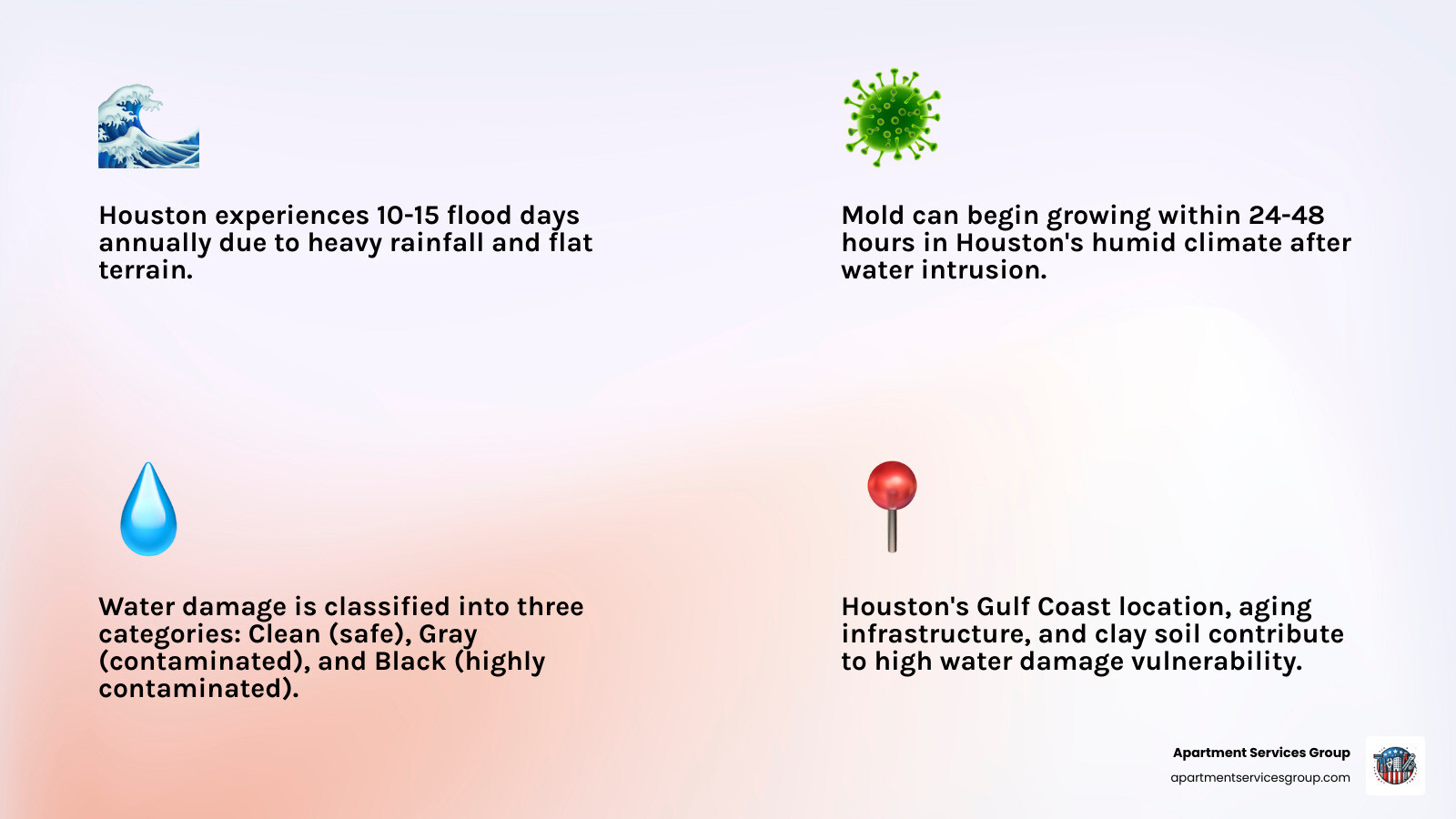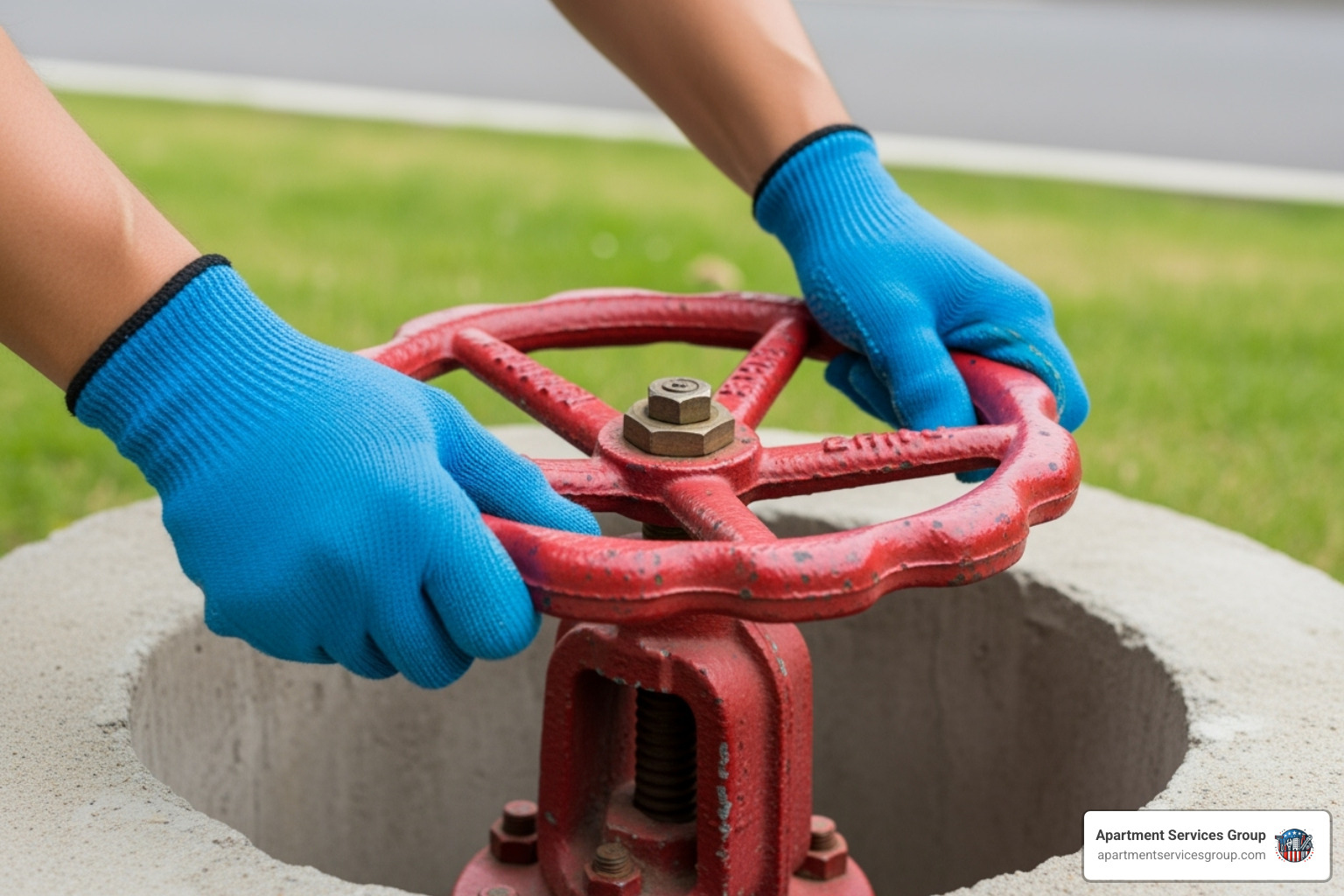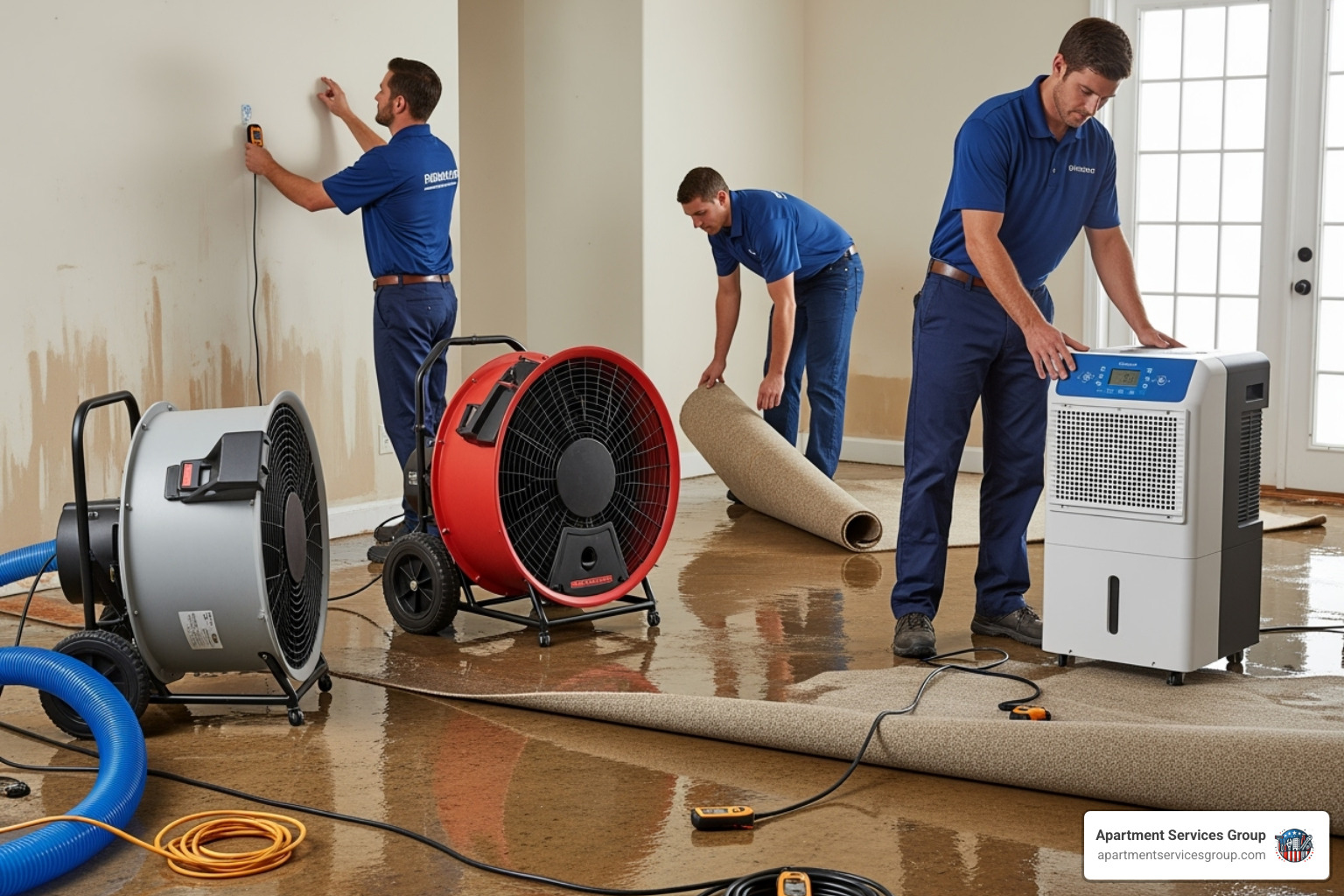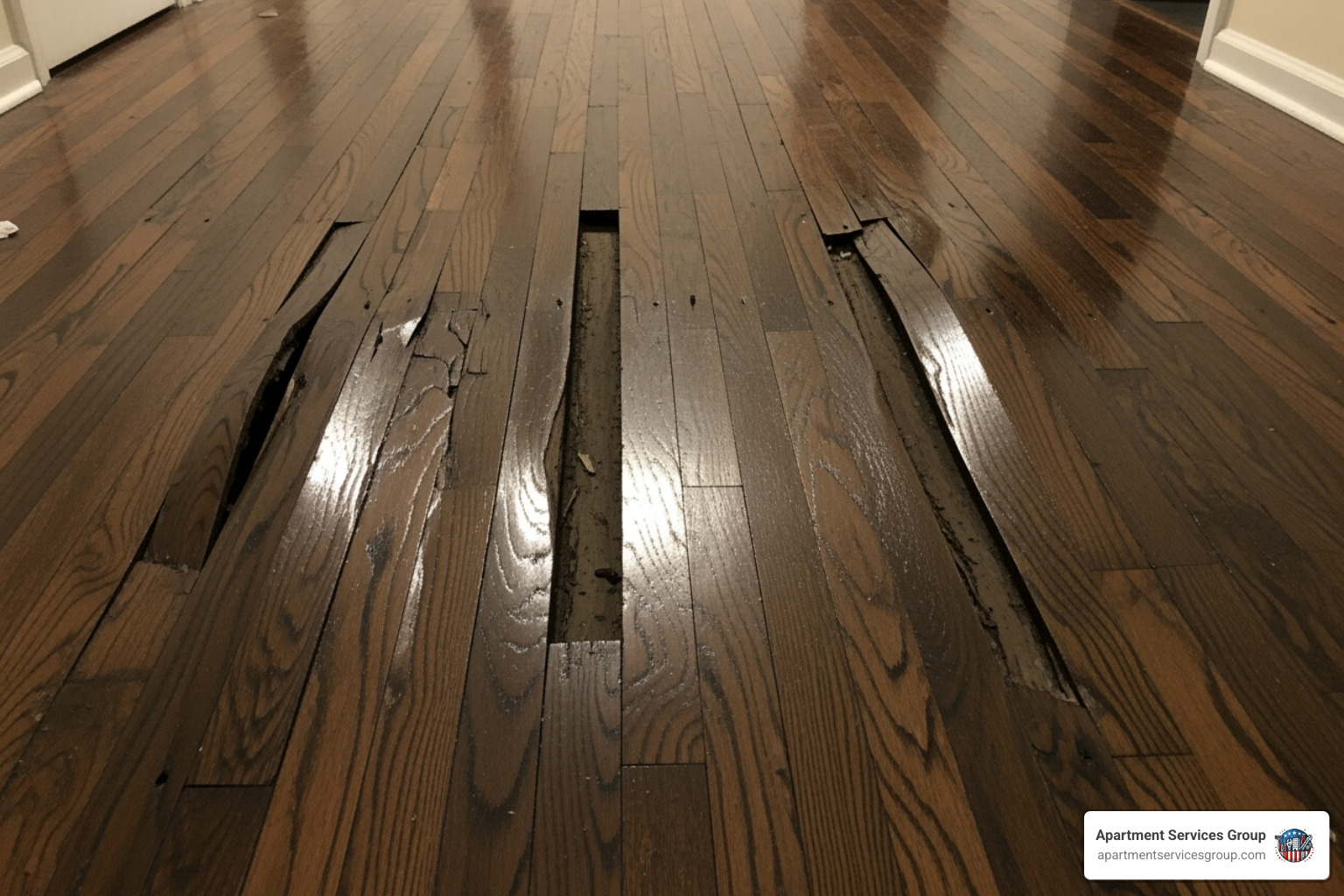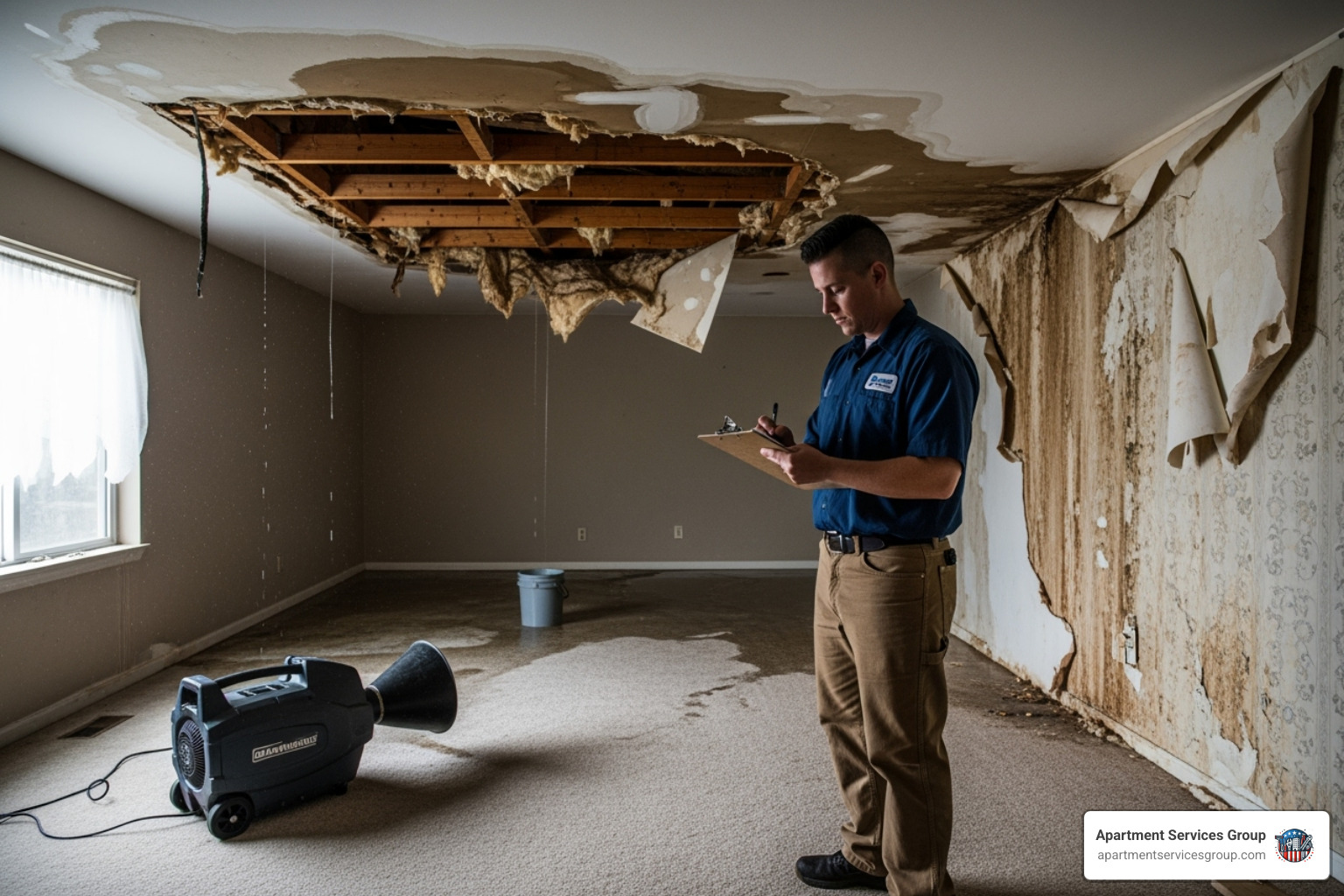Water damage Houston: 3 Expert Steps to Restore
Houston’s Water Woes: Why Our City is So Vulnerable
Water damage Houston properties face is more severe than most cities due to our unique climate challenges. From Hurricane Harvey’s devastating floods to the frequent heavy rains and high humidity that define our region, Houston homes and apartments are constantly at risk.
Quick Response Guide for Houston Water Damage:
- Turn off electricity to affected areas immediately
- Stop the water source if possible (burst pipe, appliance leak)
- Document everything with photos and videos for insurance
- Contact your insurance carrier within 24-48 hours
- Call IICRC-certified professionals for proper restoration
- Remove wet materials like insulation and drywall that won’t dry properly
Houston experiences an average of 10-15 flood days per year, making water intrusion a constant threat. Our city’s flat terrain, aging infrastructure, and position along the Gulf Coast create perfect conditions for water damage from multiple sources:
- Storm-related flooding from hurricanes and tropical storms
- Burst pipes due to temperature fluctuations and aging plumbing
- Appliance failures in high-humidity environments
- Foundation issues from expansive clay soil
The clock starts ticking immediately after water damage occurs. Mold can begin growing within 24-48 hours in Houston’s humid climate, turning a manageable water problem into a serious health hazard.
I’m Moe Shariff, owner of Apartment Services Group, and I’ve spent over eight years helping Houston property owners steer water damage Houston challenges through comprehensive restoration and renovation services. My experience managing multiple service companies has shown me how quickly water issues can escalate without proper professional intervention.
Our city’s unique position means we contend with a trifecta of water damage sources:
- Leaks: Often insidious, these stem from plumbing failures, appliance malfunctions, or roof leaks. A leaky pipe, malfunctioning water heater, or overflowing tub can cause significant localized damage, seeping into walls and subflooring.
- Flooding: From a burst pipe, overflowing toilet, or a major appliance like a washing machine, indoor flooding can spread quickly. We’ve seen entire rooms flooded from a burst pipe, requiring immediate water removal and drying.
- Storm Events: Houston’s climate makes us susceptible to severe weather. Hurricanes and tropical storms bring heavy rain and storm surges, leading to widespread flooding that can infiltrate homes. Wind-driven rain can penetrate window frames and cause significant interior damage, and we’ve seen the devastating impact of events like Hurricane Harvey.
Each type of water damage has its own challenges, but prompt action is always crucial to minimize expenses and prevent further damage.
What to Do Immediately After Finding Water Damage
Finding water damage in your home is overwhelming. Your mind races, and you’re faced with what feels like an impossible situation. But taking the right steps immediately can make the difference between a manageable repair and a devastating financial blow.
Safety first – and I can’t stress this enough. Before you even think about grabbing a mop, make sure you’re not putting yourself in danger. If there’s standing water near electrical outlets or if the water is deep, turn off the main power supply to your home. Never walk through standing water if there’s any chance of electrical hazards. I’ve seen too many well-meaning property owners put themselves at risk trying to save a few belongings.
Once you’re safe, your next priority is to stop the water source if you can identify it. This might mean shutting off the main water valve to your property, or simply turning off the supply to a leaking appliance. Every minute that water continues flowing is another minute of damage piling up.
Now comes a step that many people skip in their panic – document everything. I know it feels wrong to be taking photos when your home is flooding, but this documentation is critical for your insurance claim. Take extensive photos and videos of the damaged areas, affected belongings, and the water source if you can see it. Note the time you found the damage and any immediate actions you take. Trust me, your insurance adjuster will thank you later.
Immediate Steps for water damage Houston
Here’s where things get serious. Call a professional water damage Houston restoration service as soon as you’ve secured the scene. In Houston’s humid climate, mold can start growing within 24-48 hours – sometimes even sooner. This isn’t the time to “wait and see” or try to handle everything yourself. Professional restoration teams have specialized equipment that can extract water and dry your property in ways that regular household fans and dehumidifiers simply can’t match.
While you’re waiting for the professionals to arrive, move valuables to safety if you can do so without risk. Lift furniture off wet carpets by placing aluminum foil or wood blocks under the legs. Remove electronics, important documents, and sentimental items from the affected area.
Contact your insurance carrier within 24-48 hours of finding the damage. Many people delay this call, thinking they need to assess the full extent first, but early notification is usually required by your policy. Your insurance company can guide you through their specific process and let you know what documentation they’ll need.
For minor water incidents, you can begin removing excess water with mops, towels, or buckets. But if you’re dealing with significant flooding, this is like trying to empty a swimming pool with a teacup. Professional water extraction equipment can remove thousands of gallons in hours, not days.
One important insight from experienced restoration professionals: certain materials like insulation and drywall don’t actually dry on their own once they’re saturated. They need to be removed to prevent mold growth and structural issues. This is why professional assessment is so valuable – they can tell you what can be saved and what needs to go.
Protecting furniture that can’t be moved involves creating air circulation around it. Remove wet upholstery cushions and prop them up to dry evenly. Open windows if weather permits, and get air moving through the space.
The aftermath of water damage can feel overwhelming, but remember – you’re not alone in this. Houston homeowners deal with these challenges regularly, and there are experienced professionals ready to help guide you through the process. The key is acting quickly and making safety your top priority.
For more detailed advice from an IICRC-certified professional who’s helped countless Houston residents, check out this helpful resource: Some basic advice if you have water damage. It offers valuable insights on documentation and understanding which materials need professional attention versus what you might be able to handle yourself.
The Professional Restoration Process for Water Damage Houston
When you’re dealing with water damage Houston properties face, professional restoration is where the real magic happens. This isn’t just about mopping up water – it’s a precise, science-based process that transforms your soggy, damaged property back into the safe, comfortable space you remember.
At Apartment Services Group, we’ve spent over eight years perfecting our approach to water damage restoration. Our teams don’t just show up with a few fans and hope for the best. We bring IICRC certification and the kind of advanced equipment that makes all the difference between a quick fix and a lasting solution.
The Institute of Inspection, Cleaning and Restoration Certification sets the gold standard for our industry. When you see those letters after our technicians’ names, you know they’ve been trained in the latest techniques for structural drying, mold prevention, and safe restoration practices. In Houston’s challenging climate, this expertise isn’t just nice to have – it’s absolutely essential.
Our equipment arsenal goes far beyond what you’ll find at the local hardware store. We deploy high-powered water extractors that can remove thousands of gallons in a single session, industrial air movers strategically positioned to create optimal airflow patterns, and commercial dehumidifiers that pull moisture from the air faster than Houston’s humidity can replace it.
But here’s what really sets professional restoration apart: our moisture meters and thermal imaging cameras. These tools let us see the invisible – hidden moisture lurking inside walls, under flooring, or in ceiling cavities. Without this technology, you might think everything’s dry while water continues its destructive work behind the scenes.
From Assessment to Final Repairs: A Step-by-Step Guide
Every successful water damage Houston restoration follows the same proven pathway. We’ve refined this process through hundreds of projects, from minor apartment leaks to major hurricane damage.
Initial inspection is where everything begins. We don’t just look at what’s obviously wet – we map the entire moisture intrusion using specialized detection equipment. This creates a complete picture of the damage and helps us explain exactly what needs to happen next. We’ll identify whether you’re dealing with clean water from a burst pipe, gray water from an appliance, or black water from flooding.
Water removal comes next, and speed matters here. Our powerful extraction equipment pulls out standing water much faster than you could with household tools. The sooner we remove the bulk water, the less time it has to soak deeper into materials and cause secondary damage.
Drying and dehumidification is where the science really shows. We create controlled drying environments using strategically placed air movers and dehumidifiers. Our goal is specific: bring moisture content below 12% in materials like drywall and wood framing. Anything above 21% creates perfect conditions for mold growth, which is the last thing you want in Houston’s humid climate.
Cleaning and sanitizing ensures your space isn’t just dry, but truly safe. Depending on the water category, we apply antimicrobial treatments to prevent mold and bacterial growth. This step is especially crucial after sewage backups or flood contamination.
Restoration and rebuilding is the final phase where we make everything look like the damage never happened. This might mean simple drywall repairs and fresh paint, or it could involve replacing flooring, rebuilding walls, or even structural work. Our comprehensive approach means you work with one team from start to finish.
Because we offer extensive renovation services beyond just water damage restoration, we can handle everything from updated plumbing and electrical work to complete interior makeovers. Sometimes the best outcome after water damage is a space that’s even better than before.
More info about renovation services
How Professionals Help with Insurance Claims
Let’s be honest – dealing with insurance after water damage can feel like learning a foreign language while juggling flaming torches. That’s where professional restoration companies become your best advocates.
Documentation is absolutely critical for insurance claims, and it’s something we handle carefully. We photograph everything, track moisture readings daily, and maintain detailed logs of our work. This creates an undeniable paper trail that shows exactly what happened, what we did, and why it was necessary.
Direct billing relationships with major insurance carriers can save you significant headaches. Instead of paying out of pocket and waiting for reimbursement, we often work directly with your insurance company for covered losses. This means less paperwork for you and faster resolution of your claim.
Claims process assistance is where our experience really pays off for you. We speak the same language as insurance adjusters and understand what they need to see. We can help you steer policy requirements, answer adjuster questions, and provide the technical documentation that moves claims forward quickly.
Working with adjusters becomes much smoother when you have professionals who understand the restoration process. We can explain why certain materials need replacement rather than drying, why specific equipment is necessary, and how our timeline prevents further damage. This expertise often means the difference between a smooth claim and a frustrating back-and-forth process.
The goal is simple: get your property restored properly while making the insurance process as painless as possible. After eight years in this business, we’ve learned that good documentation and clear communication with all parties involved leads to better outcomes for everyone.
Understanding the Full Impact of Water Intrusion
When water invades your Houston property, what you see on the surface is just the beginning. Water damage Houston homes experience goes much deeper than wet floors and soggy furniture. I’ve witnessed how water can silently destroy a property from the inside out, creating problems that won’t show up for weeks or even months.
Structural integrity takes the biggest hit when water sits too long. Wood framing starts to swell and warp, while subflooring becomes spongy and unstable. In Houston’s clay soil environment, things get even trickier. Water around your foundation can cause that expansive clay to shift, leading to cracks and settling that affect your entire home’s stability.
Drywall damage happens fast and spreads quickly. Once drywall gets wet, it loses all its strength and becomes a soggy mess. The paint bubbles and peels, and the material itself starts to crumble. Here’s what many homeowners don’t realize: wet drywall doesn’t dry properly on its own. It needs to be cut out and replaced, or you’ll have bigger problems down the road.
Insulation saturation creates a hidden disaster inside your walls. When fiberglass or cellulose insulation gets soaked, it becomes heavy and useless. It can actually collapse inside wall cavities, and worse yet, it becomes a perfect breeding ground for mold. Like drywall, wet insulation rarely salvageable and almost always needs complete replacement.
Flooring issues vary dramatically depending on what type you have. Hardwood floors cup, warp, and buckle in ways that make them look like ocean waves. Laminate flooring swells up and separates at the seams. Carpet becomes a heavy, smelly mess that’s nearly impossible to properly clean and dry. Even tile can loosen as the adhesive underneath breaks down.
Electrical hazards pose immediate safety risks that you can’t ignore. Water and electricity create dangerous situations including short circuits, fires, and electrocution risks. This is why we always stress turning off power to affected areas before doing anything else.
The long-term consequences of untreated water damage extend far beyond the initial cleanup. Properties develop persistent musty odors that never seem to go away. Indoor air quality suffers, making the space uncomfortable and potentially unhealthy. Structural problems continue to worsen over time, and your property’s market value takes a significant hit. Future buyers can spot water damage signs, leading to lower offers or properties that sit on the market for months.
The Hidden Danger: Mold Growth After a Flood
Mold is the silent enemy that follows every water damage incident in Houston. Our humid climate creates the perfect storm for rapid mold growth, turning a manageable water problem into a serious health crisis.
The 24-48 hour window is critical because that’s how fast mold can establish itself. Mold spores float everywhere in our environment, just waiting for the right conditions. They need moisture, something to feed on (like wood, drywall, or fabric), and Houston’s warm temperatures. Once these conditions align, mold colonies can start growing in less than two days.
Musty odors often signal mold growth before you can see it. That earthy, damp smell means mold is actively growing somewhere, even if it’s hidden behind walls or under flooring. Don’t ignore these smells – they’re your early warning system.
Visible discoloration appears in many forms. Mold isn’t always black like people expect. It can be green, white, orange, or even pink. It might look fuzzy, slimy, or powdery. You’ll often find it creeping along baseboards, appearing on walls, or spreading across ceilings where moisture has collected.
Health risks from mold exposure affect everyone differently, but they’re always serious. People with allergies or asthma suffer the most, experiencing breathing problems, skin irritation, and eye irritation. Even healthy individuals can develop headaches, fatigue, and respiratory issues. Some molds produce mycotoxins, which are particularly dangerous and can cause severe health problems.
The importance of mold remediation can’t be overstated. Surface cleaning won’t solve mold problems because the roots go deep into materials. Professional mold remediation involves containing the affected area, using specialized air filtration, safely removing contaminated materials, and thoroughly cleaning everything that remains. We also address the moisture source to prevent the mold from coming back.
For more insights and practical advice on preventing and dealing with mold, check out our dedicated resource page with helpful tips for Houston property owners.
Frequently Asked Questions about Water Damage Restoration
When you’re dealing with water damage Houston properties face, you probably have a lot of questions running through your mind. Over my eight years helping Houston property owners, I’ve heard these same concerns countless times. Let me walk you through the answers that matter most.
How long does the water damage restoration process take?
Here’s the honest truth – there’s no one-size-fits-all answer. The timeline varies by damage severity, and I always tell my clients to prepare for a process, not a quick fix.
The assessment phase usually takes us a few hours for smaller properties, but can stretch to a full day if we’re dealing with extensive damage or a large apartment complex. We’re thorough because missing hidden moisture now means bigger problems later.
Drying time is where most of the waiting happens. For basic surface drying, we’re looking at 24-72 hours for drying, but structural drying – the kind that actually prevents mold and rot – often takes 3-5 days. In Houston’s humid climate, sometimes even longer. We use moisture meters to track progress, not just guess when things feel dry.
The repair complexity determines your final timeline. Simple cosmetic fixes might take a few days, but major reconstruction can stretch into weeks or months. I’ve seen everything from quick drywall patches to complete apartment renovations after severe flooding. Weeks for repairs is common when we’re dealing with structural damage or mold remediation.
Can I clean up serious water damage myself?
I get it – you want to jump in and start fixing things yourself. It’s natural, especially when you’re looking at the potential costs. But let me share what I’ve learned from years of cleaning up after DIY attempts gone wrong.
Minor spills vs major floods – there’s a huge difference. That coffee you spilled on your kitchen floor? Absolutely handle that yourself. But anything involving burst pipes, appliance failures, or storm flooding needs professional attention.
The contamination risks are real and serious. What starts as clean water from a burst pipe can become contaminated within hours as it picks up bacteria from building materials, dust, and debris. Storm water and sewage backups are immediately dangerous to your health.
Hidden moisture is the silent destroyer I see most often. You might think you’ve dried everything, but water loves to hide in wall cavities, under flooring, and behind baseboards. Without our moisture detection equipment, you’re essentially playing hide-and-seek with future mold problems.
Our professional equipment advantage isn’t just marketing talk. Our industrial extractors remove hundreds of gallons of water that shop vacuums can’t touch. Our dehumidifiers and air movers create controlled drying environments that rental equipment simply can’t match.
The DIY risks I’ve seen include warped hardwood floors, widespread mold growth, and structural damage that ended up costing three times more than professional restoration would have initially. Sometimes trying to save money costs you much more in the long run.
What’s the difference between water mitigation and water restoration?
This confusion comes up in almost every conversation I have with property owners. Think of it like emergency medicine versus reconstructive surgery – both are essential, but they serve different purposes.
Mitigation prevents further damage and happens immediately. When we arrive at your property, we’re in crisis mode. We stop the water source, extract standing water, remove materials that won’t dry properly, and set up our drying equipment. Mitigation is the first step – it’s about stabilizing your property and preventing secondary damage like mold growth.
Restoration repairs existing damage and begins after everything is completely dry and stable. This is where we rebuild, repair, and restore your property to its pre-loss condition or better. We’re talking about new drywall, fresh paint, replacement flooring – all the work that makes your space livable again.
Restoration is the final step in returning your life to normal. At Apartment Services Group, we handle both phases seamlessly. You don’t have to coordinate between different companies or worry about miscommunication. We take you from crisis to complete recovery under one roof.
The key thing to remember is that proper mitigation makes restoration possible. Skip or rush the mitigation phase, and you’ll be dealing with ongoing problems that make quality restoration nearly impossible.
Protecting Your Property: Your Next Steps
When it comes to water damage Houston properties face, being prepared makes all the difference. At Apartment Services Group, we’ve seen how a little prevention can save property owners thousands of dollars and countless headaches down the road.
Located right here in Houston at 16420 Park Ten Place, we understand our city’s unique challenges better than anyone. From Hurricane Harvey to sudden pipe bursts during those rare cold snaps, we’ve helped our neighbors through it all.
Prevention really is your best defense. Regular maintenance might not sound exciting, but it’s far more enjoyable than dealing with a flooded apartment at 2 AM. Check your plumbing connections every few months, especially those washing machine hoses that love to fail at the worst possible times. Keep your gutters clean – Houston’s heavy rains can overwhelm clogged drainage systems faster than you’d expect.
If your property sits in a low-lying area (and let’s be honest, much of Houston does), a sump pump could be your new best friend. These hardworking devices automatically kick in when water starts accumulating, often preventing minor flooding from becoming a major disaster.
Proper drainage around your foundation is crucial in our clay soil environment. Water should always flow away from your building, not toward it. Sometimes simple landscaping adjustments can prevent thousands in foundation repairs later.
When you do need repairs or upgrades, choosing a certified company protects your investment. IICRC certification isn’t just fancy letters – it means technicians have undergone rigorous training in industry best practices. Our certified team uses advanced equipment that goes far beyond what you can rent from the hardware store.
Speed matters when disaster strikes. Our 24/7 emergency response means we can be on-site quickly, often within hours. Those first few hours are critical for preventing secondary damage and keeping costs manageable.
We handle everything from initial water extraction to final reconstruction, so you don’t need to coordinate multiple contractors during an already stressful time. Our experience working with insurance companies also means smoother claims processing and often direct billing arrangements.
Don’t wait for a small leak to become a major headache. Whether you’re dealing with current water damage or want to discuss preventative measures for your property, we’re here to help with expert guidance and practical solutions.
Ready to protect your investment? Schedule a consultation today to discuss your water damage concerns or any other property service needs.
For apartment complex owners looking for comprehensive solutions, we offer everything from routine maintenance to emergency response services. Comprehensive apartment complex solutions can help you provide that seamless, worry-free living experience your residents deserve.


